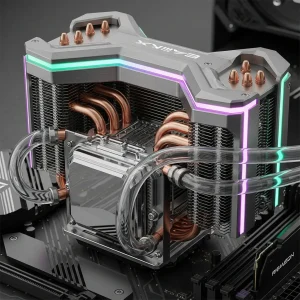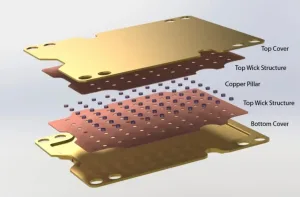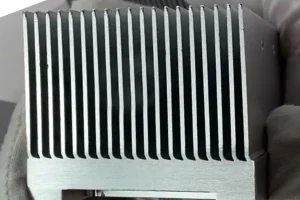Best Heat Sink Design – Your Ultimate Heat Sink Design Guide
1.Best Heat Sink Design: Understanding the Basics of Heat Sink Design
The best heat sink design is essential for efficient thermal management in electronics and industrial equipment. But what exactly makes a heat sink design “best”? At its core, the best heat sink design efficiently transfers heat away from critical components, preventing overheating and ensuring stable operation.
There are several key principles behind effective heat sink design that everyone involved in product development should know. These include maximizing surface area, optimizing airflow, and choosing materials with high thermal conductivity. A well-thought-out design of heat sink not only improves cooling efficiency but also extends the device’s lifespan by protecting sensitive electronics from thermal stress.
In practice, the design of heat sink impacts your device’s performance directly. Poor heat dissipation can cause throttling, reduce reliability, and lead to premature failure. Conversely, the best heat sink design maintains optimal operating temperatures, boosting overall product quality and customer satisfaction.
Key principles behind effective heat sink design everyone should know
A smart and efficient heat sink design follows several core principles:
Maximized surface area: More surface area allows for better heat dissipation.
Optimized airflow: Finned structures should allow air to pass freely through or around them.
High thermal conductivity materials: Most best heat sink designs use aluminum or copper, with aluminum being lightweight and cost-effective.
Thermal path efficiency: The path from the heat source to the fins should be short and direct to minimize resistance.
By following these fundamentals, engineers can ensure a heat sink design that supports better cooling performance across applications.
How the design of heat sink impacts your device’s performance and longevity
The design of heat sink plays a vital role in managing thermal loads. A well-engineered heat sink not only improves system efficiency but also prolongs the life of components by reducing thermal stress. Devices operating under optimal temperature conditions experience fewer failures, better power efficiency, and improved user satisfaction.
If you’re looking to dive deeper into material selection or geometry tips, check out our in-depth heat sink design guide here
Looking for the Best Custom Heat Sink Design?
We are a custom heat sink manufacturer with 20+ years of experience in helping clients solve high-power thermal management challenges. Whether you need assistance analyzing your drawings, running thermal simulations, or refining your heat sink design, we offer all of it — free of charge. Get in touch with us today for a tailored solution that makes your system cooler and smarter.
2. Heat Sink Design Guide: What Makes a Heat Sink Design the Best?
Choosing the right materials is one of the most critical steps in creating the best heat sink design. Aluminum and copper are the two primary metals used due to their excellent thermal properties. Aluminum is lightweight, corrosion-resistant, and cost-effective, making it ideal for many applications. Copper, while heavier and more expensive, offers superior thermal conductivity, often chosen for high-performance cooling needs.
The heat sink design also heavily depends on fin shape and size. A smart design increases surface area without obstructing airflow. For instance, tall and thin fins improve cooling by exposing more surface to air, while the spacing between fins ensures proper airflow. This balance is key to an efficient design of heat sink.
Airflow management and thermal path optimization are equally important. The best heat sink design strategically directs airflow through the fins to maximize heat dissipation. Additionally, a direct thermal path from the heat source to the fins reduces thermal resistance, improving overall cooling effectiveness.
How fin shape and size play a role in smart heat sink design
One of the most overlooked aspects in a best heat sink design is the shape and size of fins. In this heat sink design guide, we emphasize that:
Thinner, closely spaced fins are better for forced-air cooling.
Thicker, widely spaced fins are ideal for natural convection environments.
Pin fins or round fins offer advantages in turbulent airflow conditions.
The fin structure directly influences the airflow dynamics and thus the efficiency of heat dissipation. Smart fin optimization is key to a well-performing design of heat sink.
The impact of airflow and thermal paths in a great design of heat sink
Airflow is the lifeblood of effective cooling. In the best heat sink design, the airflow must be guided efficiently across the fins, while minimizing resistance. At the same time, the thermal path—the route from the heat source to the fins—must be as short and direct as possible to reduce thermal resistance.
A thoughtful design of heat sink considers both natural and forced airflow scenarios and uses simulations to test thermal paths. These decisions can drastically impact performance in real-world applications.
3. How to Design Heat Sink: Simple Steps Toward the Best Heat Sink Design
Starting with your project needs is vital in how to design heat sink for optimal performance. Designing an effective thermal solution starts with understanding the fundamentals. This guide outlines how to design heat sink systems with a focus on achieving the best heat sink design for your project — whether it’s for industrial electronics, LED cooling, or high-performance computing.
Starting with your project needs: Thermal requirements and goals
Every heat sink design should begin by clearly identifying your system’s thermal requirements. How much heat does your device generate? What is the allowable temperature rise? How compact must the heat sink design be?
Defining these parameters early helps you avoid oversizing (which adds cost) or undersizing (which compromises performance).
👉 Looking to compare materials and form factors? Check out our heat sink material comparison guide for deeper insights.
Picking the right style: Extruded, finned, or block heat sinks in the heat sink design guide
Every heat sink design should begin by clearly identifying your system’s thermal requirements. How much heat does your device generate? What is the allowable temperature rise? How compact must the heat sink design be?
Defining these parameters early helps you avoid oversizing (which adds cost) or undersizing (which compromises performance).
👉 Looking to compare materials and form factors? Check out our heat sink material comparison guide for deeper insights.
Using design tools and simulations to fine-tune your best heat sink design
Simulation plays a key role in achieving the best heat sink design. Using thermal simulation software, designers can test airflow, fin effectiveness, and surface temperature distribution before manufacturing.
Adjustments to fin thickness, spacing, or base plate geometry based on simulation results can significantly improve heat dissipation.
4. Best Heat Sink Design Tips: Small Details That Make a Big Difference
When it comes to achieving the best heat sink design, it’s not just about size or material — the real performance comes from paying attention to the small details. Whether you’re designing for high-power electronics, LED systems, or industrial equipment, understanding the nuances of heat sink design can dramatically improve thermal performance and overall efficiency.
Best Heat Sink Design with Creative Fin Layouts and Microchannel Innovations
One of the most overlooked elements in the design of heat sink structures is the layout and shape of the fins. Creative fin arrangements — such as staggered or folded fin configurations — can significantly enhance airflow and heat dissipation. Additionally, microchannels have become a go-to solution in modern heat sink design for high-power or compact devices. These ultra-thin channels increase the surface area and facilitate better thermal transfer, especially when paired with forced-air or liquid cooling systems.
Anodizing and Surface Treatment in the Best Heat Sink Design
Surface finishing isn’t just for appearance — it directly affects heat sink performance. Anodizing aluminum heat sinks not only improves corrosion resistance but also enhances emissivity, which helps radiate heat more efficiently. Other treatments like black coatings or nickel plating can be customized depending on the environment and application. Optimizing surface finishing is an essential step in any heat sink design guide.
Balancing Cooling Power, Weight, and Budget in Your Design of Heat Sink
Achieving the best heat sink design is always a balancing act. You need to weigh cooling efficiency against factors like weight, size constraints, and budget. For example, aluminum is lightweight and cost-effective, while copper offers superior conductivity but comes with higher weight and price. Matching the right material and structure to your project’s thermal needs is key.
If you’re not sure how to choose, check out our heat sink selection guide to help you navigate the options.
5.Common Questions in Heat Sink Design: Troubleshooting Your Best Heat Sink Design
Achieving the best heat sink design is rarely straightforward. Engineers often face real-world constraints that push design creativity to the limit. From space restrictions to noise control and environmental durability, understanding these challenges — and how to solve them — is key to creating high-performance thermal management systems.
Managing Space Constraints While Maintaining Optimal Heat Sink Design
One of the most common hurdles in the design of heat sink systems is limited physical space. As electronic devices get smaller and more powerful, there’s less room to install large cooling systems. To overcome this, designers often turn to extruded aluminum heat sinks with high surface area fin configurations or even integrate microchannel cold plates for precision cooling. Compact form factors like low-profile finned heat sinks offer effective thermal performance without compromising space.
Addressing Noise and Vibration in Fan-Assisted Best Heat Sink Design
When active cooling is required, integrating a fan can dramatically enhance performance — but it often introduces noise and vibration challenges. In fan-assisted heat sink designs, using optimized fan geometry, soft mounting systems, and low-noise brushless motors can help minimize acoustic impact. Matching the fan’s pressure and flow characteristics to the fin design is also critical for quiet, efficient operation.
Pro tip: Always test your fan-assisted heat sink under real load and environmental conditions to ensure stable and quiet performance.
Designing for Different Environmental Conditions in the Design of Heat Sink
Environmental factors like humidity, dust, salt spray, and extreme temperatures significantly affect the longevity and efficiency of a heat sink design. In such cases, choosing corrosion-resistant materials (like anodized aluminum), sealed enclosures, or IP-rated heat sinks ensures reliability. Surface treatments and coatings also play a role in protecting your cooling system under harsh conditions.
Tailoring your best heat sink design to your operating environment is essential — whether it’s for indoor electronics, outdoor LED systems, or industrial machinery.
6.Mastering the Best Heat Sink Design for Your ThermaManagement Needs
Recap of Essential Points in How to Design Heat Sink Effectively
Effective heat sink design starts with a clear understanding of your project’s thermal requirements and constraints. Whether you choose extruded aluminum, finned, or block heat sinks, focusing on maximizing surface area, ensuring proper airflow, and selecting the right material will drive success. Don’t forget to leverage design simulations and testing to refine your solution.
The Future of Heat Sink Design Technology and Materials
Looking ahead, the future of best heat sink design lies in innovative materials and manufacturing methods — from advanced composite materials to additive manufacturing and microchannel integration. These technologies aim to push thermal performance further while reducing size and weight.
Staying updated with the latest in thermal management technology will keep your designs cutting-edge and highly efficient.
Resources and Tools for Continuous Improvement in the Best Heat Sink Design
Continuous improvement is key to mastering how to design heat sink solutions. Utilize advanced CAD tools, CFD simulations, and thermal testing equipment to iterate and enhance your heat sink designs. Participating in industry forums, webinars, and training also helps stay on top of emerging trends.
✅ Looking for Custom Heat Sink Solutions?
As a dedicated custom heat sink factory with over 20 years of experience, we specialize in solving complex thermal challenges with tailor-made designs. We offer:
Free design consultation and thermal analysis
Custom extrusion, machining, and finishing services
Proven solutions for LED, electronics, industrial cooling, and more
📩 Reach out today for expert advice and a personalized quote — let’s create your ideal heat sink design together!



